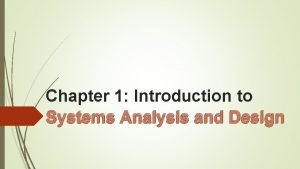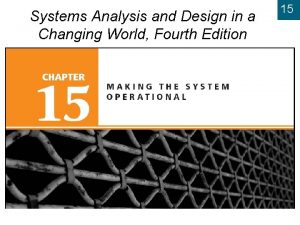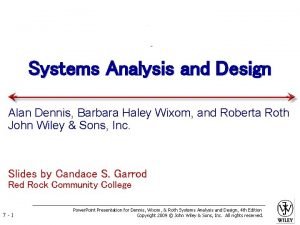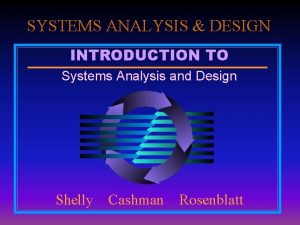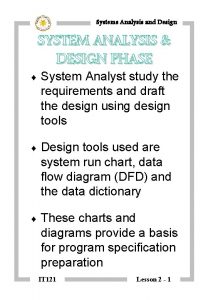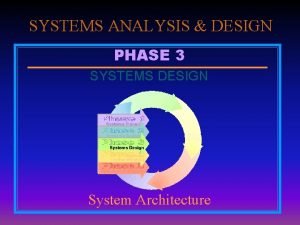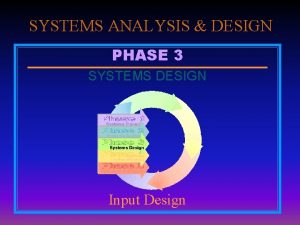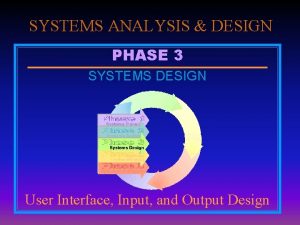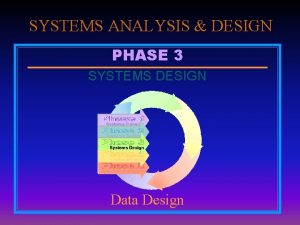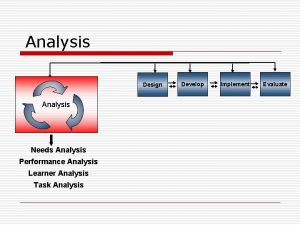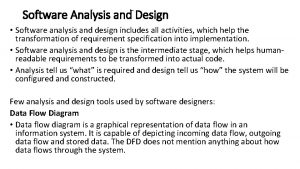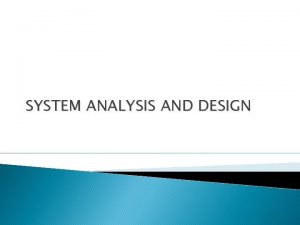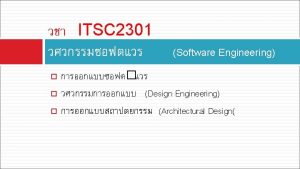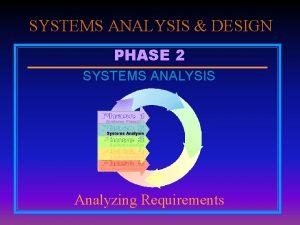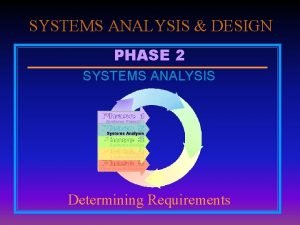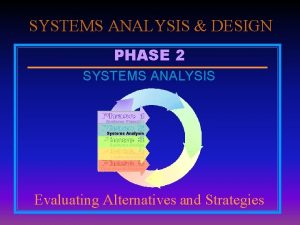SYSTEMS ANALYSIS AND DESIGN INTRODUCTION 1 Systems Analysis































- Slides: 31

SYSTEMS ANALYSIS AND DESIGN INTRODUCTION 1

Systems Analysis and Design is the process people use to create (automated) information systems n Systems Analysis & Design Information System 2

Is there an “official” name? Systems Analysis and Design! Software Engineering! Information Systems Development! Other names. . . ! Which one? 3

Systems Analyst A title given to a person who studies the problems and needs of an organization looking for improvement opportunities. Other names: • Software Engineer • Systems Engineer • Software Developer • Programmer/Analyst • Nerd or Hacker! (joking!) 4

SYSTEMS ANALYSIS AND DESIGN: A Condensed (Informal) Perspective An idea Analysis Design and Implementation Completed Information System Time 5

SYSTEMS ANALYSIS AND DESIGN: A Complete (Formal) Perspective n Systems Planning n Systems Analysis n Systems Design n Systems Planning Evolution Implementation Analysis Design Implementation n Systems Evolution 6

System Natural Fabricated Information Systems Automated Information Systems Others 7

Business “problems” come in all sizes and sh Examples: n Name & Address Book n CD Collection n Course Registration n Reservations n Student Grades n Payroll n ATM machine & Banking in General n Check-Out Counters at Retail Stores n Order Fulfillment - Mail or Web Ordering n Manufacturing n Securities Portfolio Management n Space Shuttle Flight n Election Results n Video Games (Arcade and Home) 8

System H A SYSTEM is a set of: n interrelated components n working together n for a common purpose 9

A Generic System Model (with Six Components) SYSTEM boundary processing controls inputs feedback outputs Examples: • Automobile • Student Registration System • Others. . . 10

System Model Hierarchy Template “bigger”Suprasystem System “smaller” Subsystem Example Water Vehicles Cruise Ship Staterooms 11

An INFORMATION SYSTEM is: • a type of fabricated system • used by one or more persons • to help them accomplish some task or assignment they have An Information System: • includes the 3 aspects of a system • supports policies & procedures • has three additional components - data, people, procedures - in addition to the six data people procedures 12

An AUTOMATED INFORMATION SYSTEM IS: n a type of fabricated system n used by one or more persons n to help them accomplish some task or assignment they have n utilizes hardware and software in addition to data, people, procedures n …plus all the aspects of a system data software people procedures hardware 13

An AUTOMATED INFORMATION SYSTEM has three basic characteristics to consider: DATA FUNCTIONS BEHAVIOR n DATA - input, output, or already stored electronically n FUNCTIONS - transformations or actions taken BEHAVIOR - the observable effects fromcontrol, feedback an (Plusnthe six system components: input, output, processing, 14

Systems Analysis and Design is the process people use to create (automated) information systems n data SA&D software people procedures hardware 15

H The people who do SYSTEMS ANALYSIS and DESIGN produce information systems that are: 4 used internally within the organization 4 sold commercially via mail/web order or retail store 4 imbedded in products 16

What makes Systems Analysis and Design a difficult activity? 4 Initially, problem domains (areas) tend to have poorly defined BOUNDARIES 4 Problem domain SOLUTIONS are artificial 4 Problem domains are DYNAMIC 4 Problem domain solutions usually require INTERDISCIPLINARY knowledge and skills 4 Systems Analyst’s KNOWLEDGEBASE is continually expanding 4 Systems Analysis and Design is a highly COGNITIVE activity 4 Working with PEOPLE 17

Systems Analyst’s interactions with people during Systems Analysis & Steering Committee* Users* Managers* SYSTEMS ANALYST Database Administrators * = Stakeholders Vendors Programmers & Tech. Staff Systems Analyst may be acting as a Project Manager for some of these interactions. 18

What does a Systems Analyst do? Studies the problems and needs of an organization looking for improvement opportunities for: n increasing revenue/profit n decreasing costs n improving quality of service 19

What is a Systems Analyst responsible f Effective and efficient: n CAPTURE of input data n PROCESSING & STORAGE of data n DELIVERY of timely and accurate 20

Environments/Tools Skills and Competencies of a Systems Analyst Methodologies Methods & Techniques Concepts & Principles Problem Solving & People Skills PLUS: • Functional Business Knowledge • Verbal & written communication skills • Systems Analysis and 21

General Model of Information Systems Development (“Partnership”) Stakeholder Requirements (1) Continued Involvement (5) Information System (6) Requirements Specification Analysis (3) Problem Definition Skills (2) Design and Implementation Problem Solution Skills (4) Information Technology Staff 22

Systems Analysis and Design Activities and Deliverables DESIGN ANALYSIS Activities: • Systems Planning • Feasibility Study (optional) • Requirements Determination • Conceptual Design • User Acceptance • Prototyping (optional) Deliverables: • Requirements Specification • Prototype (optional) Activities: • Physical Design • Prototyping (optional) • Software Construction/Purchase • User Documentation - “Deliverable” • Testing • Training • User Acceptance • Conversion • Implementing the system Deliverable: • Information System Two (2) additional on-going activities: • Project Management • Project Documentation - “Scaffolding” 23

Systems Analysis and Design Project Observa n Labor intensive n Smallest team = you n Next smallest team = you and one other (user) n Average team = several systems analysts and users n Articulation of the business problem is difficult 24

Where Do Systems Analysis and Design Projects Come From? n Problems - “something needs to be fixed” n Opportunities - “good deals” and are bounded byelse…” Constraints n. . . Directives - “do it…or 25

Design and Implementation Analysis SYSTEMS DEVELOPMENT LIFE CYCLE (SDLC) n Planning n Feasibility Study (optional) n Requirements Determination n Conceptual Design n Physical Design n Construction and/or Purchase (prototype) n Training n Conversion - old to new n Implementation 26

Sequential or Traditional SDLC “Begin” “End” 1. Planning for an information system 2. Feasibility Study (optional) 3. Requirements Determination (gathering) 4. Conceptual design 5. Physical design and/or purchase and/or prototyping 6. Conversion from current system to new/changed system 7. Training 8. Implementation 9. Evolution for enhancements and maintenance Waterfall or Staircase SDLC “Begin” Planning Feasibility Study Requirements Determination Conceptual Design Physical Design Conversion Training Implementation Evolution “End” 27

Iterative SDLC Spiral SDLC Activities Planning Feasibility Study Requirements Determination Conceptual Design Physical Design Conversion Training Implementation Evolution Risk Analysis Verification/Test 28

Boehm, 1988 29

Principles to Guide Systems Analysis & Des n The system is for the user n A Work Breakdown Structure should be used (ie. , SDLC) n Systems analysis and design is iterative and overlapping n Information systems are capital investments for the business n Project manager may have the authority to cancel a 30

QUITTING TIME 31
 Sad system analysis and design
Sad system analysis and design Systems analysis and design kendall and kendall
Systems analysis and design kendall and kendall System and form design
System and form design Introduction to system analysis and design
Introduction to system analysis and design Introduction of design and analysis of algorithms
Introduction of design and analysis of algorithms Difference between fea and fem
Difference between fea and fem Introduction to the design and analysis of algorithms
Introduction to the design and analysis of algorithms Systems analysis & design in an age of options
Systems analysis & design in an age of options System analysis
System analysis Systems analysis and design in a changing world
Systems analysis and design in a changing world System analysis and design in a changing world
System analysis and design in a changing world Systems analysis and design alan dennis
Systems analysis and design alan dennis Major tools of ssadm
Major tools of ssadm Systems analysis and design 5th edition
Systems analysis and design 5th edition Modern systems analysis and design
Modern systems analysis and design Kendall and kendall system analysis and design
Kendall and kendall system analysis and design Systems analysis and design alan dennis
Systems analysis and design alan dennis Systems analysis and design alan dennis
Systems analysis and design alan dennis Systems analysis and design alan dennis
Systems analysis and design alan dennis Systems analysis and design alan dennis
Systems analysis and design alan dennis Systems analysis and design alan dennis
Systems analysis and design alan dennis Systems analysis and design alan dennis
Systems analysis and design alan dennis Systems analysis and design alan dennis
Systems analysis and design alan dennis Structured systems analysis and design method
Structured systems analysis and design method Radar systems analysis and design using matlab
Radar systems analysis and design using matlab Object-oriented systems analysis and design using uml
Object-oriented systems analysis and design using uml A modern approach to systems analysis and design
A modern approach to systems analysis and design Patched-up prototype
Patched-up prototype Systems analysis and design in a changing world
Systems analysis and design in a changing world Systems analysis and design in a changing world
Systems analysis and design in a changing world Systems analysis and design in a changing world
Systems analysis and design in a changing world Systems analysis and design alan dennis
Systems analysis and design alan dennis



